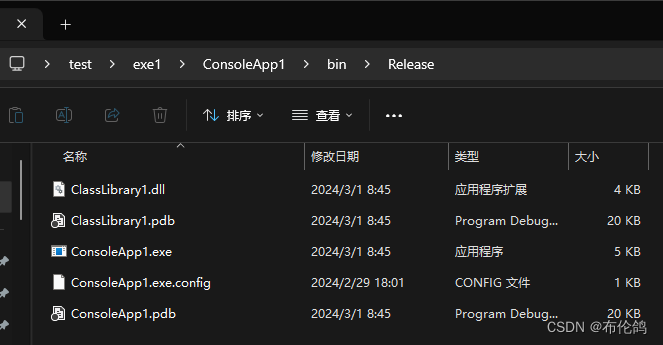先说结论:如果应用程序项目中使用直接引用的形式调用动态链接库,当动态链接库是在调试模式生成的情况下,即使应用程序以发布模式生成,跟随应用程序一同生成的动态链接库仍为调试模式,会引发DLL实现泄露问题;当动态链接库是在发布模式生成,则不论应用程序的生成模式,都无法通过跟随应用程序一同生成的动态链接库查看内部实现细节,需注意。
实验条件:
两个控制台工程,一个类库工程。

类库工程内容如下:
using System;
using System.Collections.Generic;
using System.Linq;
using System.Text;
using System.Threading.Tasks;namespace ClassLibrary1
{public class Class1{public void ConsoleWriteLineA(){Console.WriteLine("A");}}
}
控制台工程内容如下:
using System;
using System.Collections.Generic;
using System.Linq;
using System.Text;
using System.Threading.Tasks;namespace ConsoleApp1
{internal class Program{static void Main(string[] args){ClassLibrary1.Class1 class1 = new ClassLibrary1.Class1();class1.ConsoleWriteLineA();Console.Read();}}
}
using System;
using System.Collections.Generic;
using System.Linq;
using System.Text;
using System.Threading.Tasks;namespace ConsoleApp2
{internal class Program{static void Main(string[] args){ClassLibrary1.Class1 class1 = new ClassLibrary1.Class1();class1.ConsoleWriteLineA();Console.Read();}}
}
实验步骤:
在调试模式下生成DLL,在Exe1项目中直接引用DLL,在发布模式下生成Exe1,此时Exe1的默认生成路径下内容如下:

在Exe2项目中调用Exe1默认生成路径下的DLL,此时进行Exe2项目调试时,能够通过DLL方法查看DLL内部实现。

如果将Exe1项目中直接引用的DLL改为发布模式下生成的DLL,再以Exe2项目直接引用Exe1默认生成路径下的DLL,则会弹窗:

也无法进入DLL查看内部实现。






)




)



)

![[AutoSar]BSW_Com06 CAN报文应用层到Can总线的函数调用](http://pic.xiahunao.cn/[AutoSar]BSW_Com06 CAN报文应用层到Can总线的函数调用)

